
Sea Of Thieves review
Sea Of Thieves is unlike any game that Rare has ever made. Beyond that, one could be so bold as to say that it is unlike any game that has ever been made. Rare calls it a SWAG (Shared World Adventure Game), and this is a categorization that works very well in describing just what it is. Sea of Thieves is a game that gives its players an open sea on which they can go on infinite adventures with friends (or random strangers), providing emergent experiences that stem from a set of creative mechanics and social interactions. This game succeeds in providing a platform to act out one’s piratical fantasies, creating memories with crewmates and rival buccaneers alike. On the flip side of that, however, it does come up a few paces short of the metaphorical X on the map in certain aspects of its launch-day package.
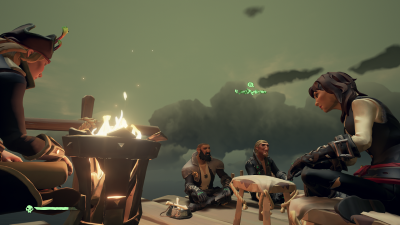
Upon booting the game on either Xbox One or Windows 10, players are brought into a virtual tavern for the game’s front-end user interface. Those who have been long-time fans of Rare may see this as a nod to Conker’s Bad Fur Day, though as of now no one from the company has gone on record to confirm that. After pressing any button, the game begins a short cinematic with the camera panning over a map that’s laid over one of the tavern’s tables. In verse, the setup for the game is presented to the player as images and text fade into the empty spaces on the map with a painterly look to them. It tells of a fortune to be found in the Sea Of Thieves and that to get there, one must traverse a hidden route under a fearsome sky.
This presentation also makes mention of the game’s three Trading Companies and their motivations for coming to the region. The Gold Hoarders have come to seek chests that lie beneath the sands, the mysterious Order Of Souls are after the skulls of history and the Merchant Alliance seek to make their share of coin by way of trading goods. The cinematic ends with the final verse of “Athena’s Fortune now calls to ye, to become a legend upon the sea.” At this point an overall objective is set for the player, but there is little other guidance as to how to obtain said fortune or achieve this status.
Control is then given to the player to select a character by way of the Infinite Pirate Generator, or IPG for short. Rare opted to go with a controlled approach to character selection rather than full character creation. By utilizing a set of assets that can randomly and interchangeably be assembled into a character, the IPG essentially makes a unique avatar for the player rather than giving them the option to adjust sliders or manipulate any aspects of a character. While many character customization options lie within the game, such as clothing, hair stylings, and items like hooks and peg legs, the IPG prevents the player from choosing things like hair or eye color, or even tattoos or scars. This lack of more in-depth customization options is a bit of a problem; you may find a near-ideal pirate for yourself, only to find that it may have a hair color that you are not particularly fond of. You may also not be able to tell its hair color, as the lighting in this interface is that of a poorly lit tavern. Different light sources in the selection area have different hues to them, adding to the issue of being able to tell what exactly it is you are going to get.
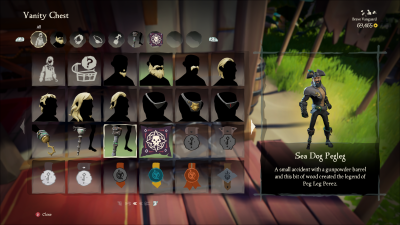
The game sets up eight randomly generated characters in a circle around a wooden pillar within the tavern. There’s a button that allows the player to cycle in eight newly generated pirates, with another button available to lock ones in place while others are generated around them. There is no option to zoom in or manipulate your character’s pose; they are pre-determined based on the slot they are in. Some will be holding kegs, while others have tankards of grog, among several other props and stances. Different facial expressions are paired with these poses, further hindering the player from getting a firm grasp at what their character’s default look will be. Though the system creates some ultimately great-looking pirates, it does leave a lot to be desired, especially in a game whose original tagline was “Be the Pirate You Want to Be.” Rare has stated that it intends to add customization options for character hair color and tattoos to the in-game customization system, but as of launch neither of those have the option to be changed.
Once the player selects their pirate of choice, the game takes them to a scene with their selected character raising a tankard in front of the tavern’s bar. It presents the option to select a ship size which are a large galleon for three- or four-player experiences, or a small sloop for one- or two-player adventures. Once the player chooses their desired vessel and crew makeup, the game enters into a loading screen full of hints and tips, once again presented in verse.
The player’s very first spawn into the game has them waking up at a table in one of the game’s taverns. Before control is given, the player picks up a banana off the table, as well as a map. The game then turns over control and teaches the player how to view and select items from their inventory, and then how to select and view a map. It then instructs them to obtain a voyage from one of the game’s Trading Companies. It also explains how to start a voyage and what to do with the spoils you acquire whist on your journey. While it could be argued that this game is more fun when you are discovering its mechanics on your own, the tutorial is important for players who are not aware of what the game is or how it works.
That said, it is implemented in a way that is problematic, especially for players who join into a crew session rather than going solo. I have seen multiple videos of players spawning into the tutorial while their crew is off mid-voyage somewhere else in the game world. This creates some pretty strong confusion, as well as not giving the player a proper representation of what spawning into a non-tutorial game experience will be like. On-screen pop-ups of their crewmates starting a voyage, digging up a chest, or even selling items to a Trading Company representative can all potentially occur. In the instances I’ve seen where this has happened, the new player is confused as to why that’s happening and is also confused as to why they have spawned into the game without a ship. Further misunderstanding can occur when they hear their crew talking over voice chat.
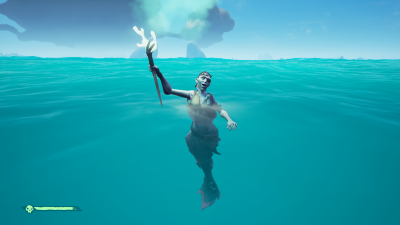
An in-game mechanic revolving around friendly mer-people aiding players back to their ships is not explained in the tutorial, and therefore a random blue person bobbing offshore with a blue flare and rising smoke is lost on the player. Though it does usually provoke enough interest for the player to investigate, the player may or may have not finished their tutorial session at the outpost before interacting with the mer-person, thus whisking them away to their ship to join their crew.
Ultimately the player should be able to grasp what it is they need to do, either by their crewmates showing them the ropes, or through pure trial-and-error exploration. As mentioned before, it is fun to discover how gameplay elements work and why. The game’s tutorial either needs to be a stand-alone experience that is the same for all players, or it needs some tweaking to allow it to be dynamic based on the situation a player spawns in to. Having the player wake up on the ship and go through an ‘already-at-sea’ tutorial that then goes on to explain mechanics back at an outpost whenever the player first visits one would help considerably.
Once the player is finally through with the tutorial, they are essentially set free in the world with all skills and mechanics available to them at the start. Many players may find this as a shock, as it means that there is no progression in terms of discovering new moves or skills. There is no powering up of weapons or stats like speed, strength or agility. The game is essentially a pirate simulator sandbox game where all players are on an equal playing ground. The rewards and progression of the game are based around cosmetic upgrades of clothing, hair styles, props like hooks and peg legs, titles, visual item variations, and some select ship customization.
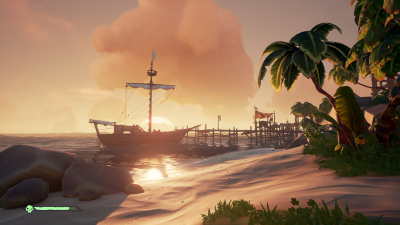
So few games in this modern era set players free like this, and many players may find themselves lost and unsure of what to do. There are no on-screen checkpoints or minimaps. Even health and ammo are only shown when you have taken damage or are actively holding a weapon that uses ammo. Other pop-ups do occur, such as when a voyage has begun, certain objectives are completed, or each time you get near enough to an island for its name to pop up while at sea.
Once you come to grips with the lack of specific direction, it’s refreshing to just be able to play. It can be compared to being a child and just playing pirate in the school yard. You decide what you want to seek or where you want to go; you decide the kind of adventure you want to go on. In this regard, this game has endless possibilities and each experience with it is truly unique. Many items in the game exist simply as, in the words of its developers, “social lubricants.” That is, getting your character drunk on grog serves no real gameplay purpose beyond just being funny to watch. Yet players can set their own goals, like a race from the tavern to the ship while intoxicated, or who can reach the end of the dock without falling off.
As stated before, the game has three Trading Companies that serve up voyages. Voyages are quests that players complete to earn gold, the game’s currency used to purchase the aforementioned customization items. Voyages from each Trading Company are different, yet relatively similar: they are all essentially fetch quests to bring something of value to the Trading Company from which you received your assignment. The Gold Hoarders give you maps or riddles that guide you to buried treasure. The Order of Souls give you a skeleton bounty target and an island name. The Merchant Alliance give you lists of items they need delivered to a specific outpost by a certain date and time.
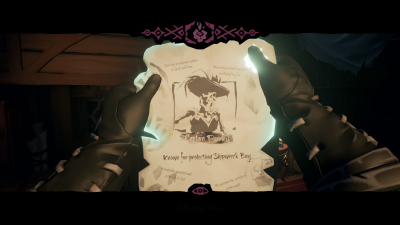
If you simply play the game to complete voyages, things can get repetitive relatively quickly. As a video game, many players may find the core gameplay loop to be shallow and unrewarding. But going back to the “playing pirate” metaphor from before, the fun comes from the journey, not the destination. Creating your own fun is equally as important in this game as following its directions for voyages.
Sometimes you may just want to go explore an island. There are occasionally items of value washed up on shore, or chests may be found out in the open somewhere. Ancient statues and rock paintings tell tales of an ancient civilization and some of the struggles they faced. This world is rich in detail and history and discovering that is fun in and of itself. You may also come across names (Xbox Live Gamertags) of pirates etched into the environment – documenting tales of other players who have done notable actions in the game or among the greater community. Exploration can stem below the waves as well, as there are shipwrecks that may appear throughout the world, sometimes packed with treasures to plunder, or underwater caves and artifacts can also be discovered.
Beyond exploration, there are plenty of other ways you can create your own fun in this game. You can try and set up a race with another ship or attempt to blast yourself out of a cannon to the highest point on an island. You can sneak aboard an enemy ship and steal their loot, or you can engage another crew for a full-on nautical battle. Again, the tools that the game presents to the players can be used in countless ways, and often allow for unexpected results.
The shared world aspect of the game means that even when you are aiming to do one thing, another crew of players can show up at any time and muck it up. They can also provide a collaborative experience. There is no way to know until you engage with them. The game uses a proximity voice chat function for people who are not on your own crew. You can use this to speak to them to engage in previously mentioned activities, or you can be stealthy and use it to spy on other crews’ motivations. Many of my own most memorable moments have come from joining up with other crews – either to create an armada, or just one big party boat full of drunken sailors.
Collaboration is also a great way to conquer the game’s Skeleton Forts – the game’s take on raid quests. Every so often, a skull-shaped cloud will appear somewhere in the game’s sky, visible from any point in the world. Players must sail towards it to find a fortress occupied by skeletons of varying types and weapon loadouts. To win the raid, players must defeat several waves of hostile skeletons and then defeat a legendary captain in the final wave. Upon defeat, the captain will drop a special key that will open a vault below the fortress. The vault is full of many types of treasure that can be sold to all three of the Trading Companies.
The game’s only land-based AI enemy threats are skeletons. There are four skeleton types: standard, shadow, plant, and golden. Standard skeletons are, pardon the pun, fairly barebones – a few shots or swipes of a sword and they can be thwarted. Shadow skeletons appear to be invulnerable when in the dark of night and require the player to raise a lantern to stun them and make them susceptible to damage. During the daytime they are always vulnerable and present much less of a threat. Plant skeletons seem to be more vulnerable to sword damage. They also have the ability to heal in water and are invulnerable while standing in it. Golden skeletons are heavy and slow, and they do not take damage from swords. Splashing them with water from your bucket or drawing them into water will slow them down to a snail’s pace, allowing you to destroy them fairly easily with your firearms.
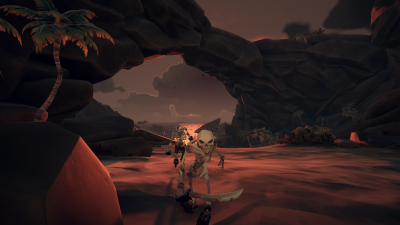
While it is definitely possible to defeat a Skeleton Fort as a single crew, it can be great fun to form an uneasy alliance with one or more other crews to vanquish the skeleton threat more easily. Dividing up the rewards at the end can be a civil and diplomatic scenario, or all hell can break loose as one member betraying another team can cause an all-out war to erupt.
The other AI threats in the game are that of the sea. The more common one is the shark. They behave much as one might expect sharks to behave: they’ll circle players in the water and will eventually charge them and take a bite. They are usually manageable on their own, as they can be defeated with two or three gunshots or a few sword slashes. However, some areas of the world are teeming with sharks, and a shiver of them can make quick work of players if they are not careful. When players explore shipwrecks, sharks can sometimes appear around them and will begin circling the submerged vessel, awaiting the player’s emergence. A smart player can strategize a clean getaway by waiting for a shark to swim by an opening and paddling for their own ship as quickly as possible.
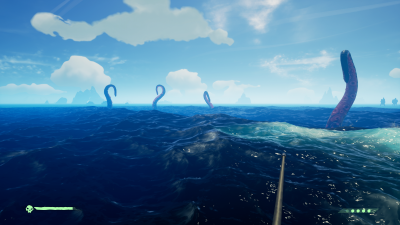
The other nautical AI threat in the game is its mighty kraken. The kraken moves about the world undetected by players. There is no immediate way to tell if it is near. When it does attack, however, it blackens the water surrounding a ship with its ink, and its tentacles emerge from the water all around. It can wrap the ship up and cause damage to it, or it can suck players into one of its terrifying tentacle mouths and dunk them in an attempt to drown them. The only way to escape is for another player to damage that specific tentacle.
Ultimately, the kraken battle lacks much in the way of threat, as its damage to ships is fairly limited and the tentacles that aren’t wrapping up the ship don’t do anything other than occasionally suck a player away from the deck. The inky water merely slows your ship down, so as long as you straighten your wheel and keep your sails down, you’ll eventually escape the battle. You can also drop anchor and fight it until it flees but doing so does not currently yield a reward and therefore is a bit of a waste of resources. It does feel good to conquer the beast, especially the first time, so it may be worth it to try it once to prove you and your crew’s worth.
Sea Of Thieves is an experience that is far greater than the sum of its parts. On the surface it is a shallow pirate simulator with beautiful graphics and incredible sound design. The quests lack great depth or variety and its AI threats are on the lean side, but when you stop trying to treat it as an A to B experience of endless quest grinding, the game can take hold of you and give you more amazing experiences and new friendships than you could ever imagine. The unexpected encounters with other players are truly what this game is all about, and those emergent experiences are worth their weight in gold. Add to that the fact that Rare already has a roadmap to continue to support and extend the game in numerous ways, and the fun should only increase in even more new and unforeseen ways the longer it is out.
As it exists in its launch state, Rare Gamer gives Sea Of Thieves 8 out of 10
Categories: Reviews
1 Comment
1 person has commented; don\t leave that person hanging - get involved and add your own comment.